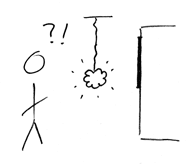| back to index | |||
H12 Innovative Appearance * |
|||
 Rhythm Tree interactive music system [MIT Media Lab, 2000]. |
|||
|
...you are designing an interactive exhibit, and you have
decided to attract visitors in some way - Attraction Space. Now you need to find methods to establish
this attraction.
|
|||
|
* * *
|
|||
| The most established user interface hardware and software
is often also the most boring. |
|||
| WorldBeat: batons |
The WorldBeat music exhibit uses infrared batons as input devices. They are unlike anything visitors have normally used up to now to interact with a computer, which makes the exhibit look interesting and promises an experience from which something new can be learned. |
||
| Virtual Vienna: NaviPad |
The Virtual Vienna city tour uses a custom-designed NaviPad to move around in the three-dimensional photorealistic panoramas. The same degrees of freedom could be made accessible through a standard joystick and additional slider, but they would not only be less appropriate for the domain of a city tour, but also less innovative for visitors than a custom-designed device. It is often enough to "wrap" standard devices into an innovative outer shape to decouple the impression of the system from known modes of interaction. |
||
| Brain Opera: Rhythm Tree |
The Brain Opera music exhibit by the MIT Media Lab features, among other parts, large rubber forms resembling ears, noses, etc. that can be punched and pressed by visitors to create various sounds (see the opening picture). The shape and physical mode of operation of these input devices alone are intriguing enough to attract people to use this exhibit who would hardly have stopped to achieve the same results at a computer exibit solely equipped with mouse and keyboard. |
||
|
Therefore: Choose input and output devices that look different from standard computing periphery. Raise the curiosity of visitors by offering new channels and modalities of interaction as part of the user experience. |
|||
 |
|||
|
* * *
|
|||
|
If the subject of the exhibit does not happen to be
technology itself, it is usually more attractive to hide standard
hardware - Invisible Hardware. The new
appearance of your system, with some new modality of interaction, may even
allow you to do away with other more standard devices - One Input Device.
|
|||
This pattern is taken from the book "A Pattern Approach to Interaction Design" (PAID) by Jan Borchers (John Wiley and Sons, Chichester, UK, 2001). Copyright 2001 John Wiley and Sons. Used by permission. See http://media.informatik.rwth-aachen.de/paid.html for more information. Online version by Susan Babutzka, ETH Zurich (subabutz_at_student.ethz.ch). |
|||